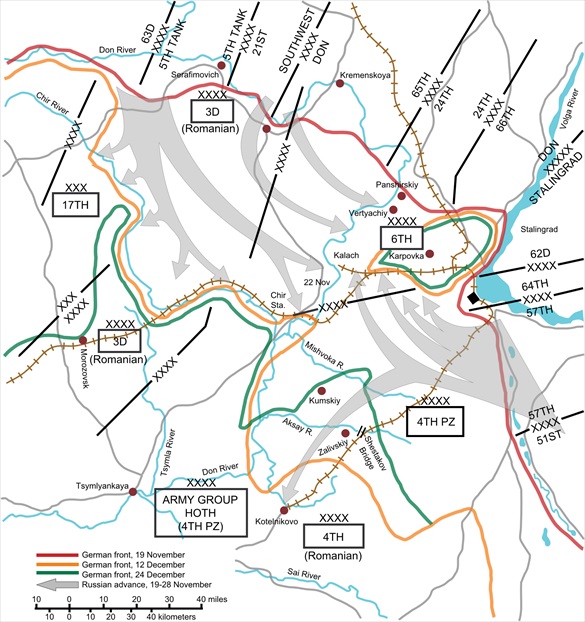STALINGRAD, BATTLE OF (AUGUST 1942–FEBRUARY 1943)
| When | August 23, 1942 to February 2, 1943 |
| Where | Stalingrad (today’s Volgograd), an important industrial city of 400,000 people and river and rail terminus on the Volga River
|
| Who | The German Sixth Army under Gen. Friedrich Paulus (1890–1957); elements of the Fourth Panzer Army under Gen. Hermann Hoth (1885–1971); along with Germany’s satellite armies, the 2nd and 4th Romanian Armies, the Hungarian 2nd Army, and the Italian 8th Armies. Opposing force was the Soviet Army’s Stalingrad Front, principally the Sixty-Second Army under Lt. Gen. Vasily Chuikov (1900–1982). |
| What | German forces, which at the outset numbered 300,000 troops and 2,000 tanks, nearly succeeded in conquering Stalingrad, but with massive losses. Soviet forces numbered 1.1 million strong, with 3,500 tanks. The unexpected Soviet counteroffensive, begun November 12, 1942, trapped 250,000 Germans within the city, where close to 150,000 perished. Some 110,000 troops, weakened by starvation, cold, and typhus, went to almost certain death in Soviet captivity. Only about 5,000–6,000 POWs survived to return home. Soviet losses were 480,000 killed and missing. Between the combatant sides, almost two million lives were lost. |
| Why | The apocalyptic struggle for Stalingrad was part of a German campaign to occupy the Soviet Union’s three major oilfields in the Caucasus south of the city. Stalingrad, with its symbolic name, was initially a secondary target to protect the German left flank. For their part, the Soviets needed a victory at Stalingrad to launch an offensive against the German invaders. |
| Outcome | The failure of Hermann Goering’s Luftwaffe to supply German troops trapped in the Stalingrad Pocket resulted in food and ammunition shortages that sabotaged a German victory in the East. Nazi Propaganda Minister Joseph Goebbels correctly noted in his diary, “We are in danger of bleeding to death in the East.” The Sixth Army’s liquidation was a stunning blow to army and home-front morale and to Hitler’s own plans to liquidate the Soviet Union (Operation Barbarossa). It was a turning point in World War II and marked the beginning of the Axis defeat on the Eastern Front as 4.5 million Soviet troops began a cascading series of offensives that engulfed everything before them. It was Chuikov, twice-decorated Hero of the Soviet Union, who accepted the surrender of Berlin’s garrison on May 2, 1945. |
![]()
The Battle for Stalingrad, August 1942 to February 1943
![]()


 History buffs, there is good news! The Daily Chronicles of World War II is now available as an ebook for $4.99 on Amazon.com. Containing a year’s worth of dated entries from this website, the ebook brings the story of this tumultuous era to life in a compelling, authoritative, and succinct manner. Featuring inventive navigation aids, the ebook enables readers to instantly move forward or backward by month and date to different dated entries. Simple and elegant! Click
History buffs, there is good news! The Daily Chronicles of World War II is now available as an ebook for $4.99 on Amazon.com. Containing a year’s worth of dated entries from this website, the ebook brings the story of this tumultuous era to life in a compelling, authoritative, and succinct manner. Featuring inventive navigation aids, the ebook enables readers to instantly move forward or backward by month and date to different dated entries. Simple and elegant! Click 











